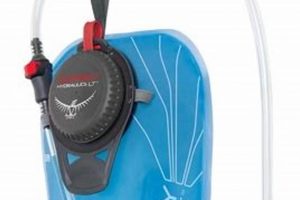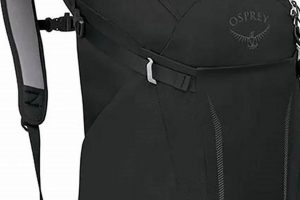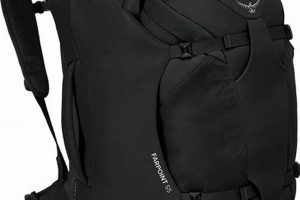A hydration system component designed for integration with Osprey backpacks, this reservoir facilitates convenient water access during outdoor activities. Typically constructed from durable, BPA-free materials, it features a wide opening for ease of filling and cleaning, along with a bite valve and hose for on-the-go hydration. These reservoirs come in various sizes to suit different backpack capacities and user needs. For example, a 3-liter reservoir would be suitable for longer hikes, while a 1.5-liter option might suffice for shorter excursions.
The incorporation of a water reservoir into a backpack streamlines hydration, allowing individuals to drink without stopping or removing their pack. This enhances efficiency and safety during activities like hiking, cycling, and trail running. Historically, carrying water involved separate bottles or canteens, which required interrupting the activity to access them. These reservoirs provide a hands-free solution, enabling continuous movement and minimizing disruption. The design also minimizes the risk of spills and contamination.
The following sections will delve into specific features, maintenance procedures, compatibility considerations, and common issues associated with these hydration systems. Examination of cleaning techniques, storage recommendations, and troubleshooting tips will provide a complete understanding of their effective utilization. Furthermore, a comparison of different models and sizes will assist in selecting the appropriate option for particular needs.
Osprey Backpack Bladder
Optimal performance and longevity of the hydration system rely on proper usage and care. Adherence to the following tips will ensure a reliable and hygienic water source during outdoor pursuits.
Tip 1: Proper Filling Technique: Avoid overfilling the reservoir. Overfilling can cause leaks and make it difficult to insert into the backpack’s hydration sleeve. Fill to the maximum fill line indicated on the reservoir.
Tip 2: Regular Cleaning is Essential: After each use, drain the reservoir completely and rinse with warm, soapy water. Use a cleaning kit with brushes designed for cleaning the reservoir body and hose to remove any residue or buildup.
Tip 3: Thorough Drying Prevents Mold: After cleaning, ensure the reservoir and hose are completely dry before storing. Use a reservoir hanger or prop open the reservoir to allow air circulation. Failure to dry thoroughly can lead to mold growth.
Tip 4: Avoid Storing in Direct Sunlight: Prolonged exposure to direct sunlight can degrade the reservoir material. Store the clean, dry reservoir in a cool, dark place.
Tip 5: Inspect for Damage Regularly: Before each use, carefully inspect the reservoir, hose, and bite valve for any signs of damage, such as cracks, tears, or leaks. Replace damaged components immediately.
Tip 6: Use Appropriate Liquids Only: The reservoir is designed for water. Avoid filling it with sugary drinks, juices, or other liquids that can leave residue and promote bacterial growth. If using electrolyte solutions, rinse the reservoir thoroughly after each use.
These guidelines are crucial for maintaining the hygiene and structural integrity of the hydration reservoir, ensuring a safe and dependable hydration solution during various activities. Implementing these practices will contribute to a more enjoyable outdoor experience.
The following sections will further address troubleshooting common issues and selecting the correct reservoir size for specific applications. Understanding these aspects will contribute to optimal reservoir functionality.
1. Material Durability
Material durability is a critical factor in determining the lifespan and performance of an Osprey backpack bladder. The materials used directly impact the reservoir’s ability to withstand the rigors of outdoor use, including abrasion, temperature fluctuations, and repeated filling and emptying.
- Abrasion Resistance
The reservoir material must resist abrasion from contact with the backpack’s interior, other gear, and the user’s body. Polyurethane (TPU) films are often employed due to their high abrasion resistance. A bladder constructed from less durable material may develop leaks over time due to chafing and wear.
- Puncture Resistance
Exposure to sharp objects, both inside and outside the backpack, necessitates a puncture-resistant material. Multi-layer films or reinforced fabrics offer enhanced protection against punctures. A compromised bladder can lead to water loss and render the hydration system unusable.
- Temperature Stability
Hydration reservoirs are subjected to varying temperatures depending on the environment. Materials must maintain their flexibility and structural integrity in both hot and cold conditions. Some materials become brittle at low temperatures, increasing the risk of cracking.
- Chemical Inertness
The reservoir material must be chemically inert to prevent the leaching of harmful substances into the water. BPA-free and phthalate-free materials are standard. Prolonged exposure to certain chemicals can degrade the material and contaminate the water supply.
The selection of durable materials directly correlates with the long-term reliability and safety of hydration reservoirs integrated with Osprey backpacks. Investing in a bladder constructed from high-quality, abrasion-resistant, and chemically inert materials ensures a prolonged service life and minimizes the risk of failure in demanding outdoor conditions.
2. Capacity Options
Capacity options are a fundamental consideration when selecting a hydration reservoir for integration with an Osprey backpack. The volume of the reservoir directly impacts the amount of water available and the duration of activities that can be supported. Insufficient capacity leads to dehydration, while excessive capacity results in unnecessary weight and bulk. The selection process necessitates a careful evaluation of individual needs and planned usage scenarios.
For example, a short day hike in moderate temperatures may require a 1.5-liter reservoir. In contrast, a multi-day backpacking trip in arid conditions could necessitate a 3-liter or larger capacity. The correlation between activity duration, environmental factors (temperature, humidity), and individual hydration needs dictates the optimal reservoir size. Real-world examples highlight the consequences of mismatched capacity; a runner completing a marathon with an inadequate water supply risks performance degradation and potential health complications. Conversely, a casual walker carrying an oversized reservoir experiences unnecessary strain and discomfort. Osprey offers a range of bladder sizes to meet diverse needs, including 1.5L, 2.5L, and 3L options. These options allow users to match their individual needs to their activities.
Selecting the appropriate capacity is therefore a critical component of ensuring safe and efficient hydration while utilizing an Osprey backpack. Understanding the relationship between activity demands, environmental conditions, and individual water consumption allows for informed decision-making. Failure to adequately assess these factors can compromise performance, comfort, and safety. Considerations should be given to factors like refill opportunities and the activity level, as well as expected weather patterns.
3. Cleaning Ease
The ease with which a hydration reservoir can be cleaned directly influences its hygiene and longevity. Residue buildup promotes bacterial growth, potentially contaminating water and compromising user health. Therefore, the design features of a hydration bladder significantly affect the practicality of maintaining a clean and safe water source.
- Wide-Mouth Opening
A wide-mouth opening facilitates access for cleaning tools and visual inspection. Narrow openings restrict access, making it difficult to scrub interior surfaces effectively. A wide opening allows for thorough cleaning and drying, crucial for preventing mold and bacterial proliferation.
- Smooth Interior Surfaces
Smooth interior surfaces minimize the adherence of residue. Textured or corrugated surfaces provide more area for bacteria to attach and make cleaning more challenging. Smooth surfaces are readily rinsed and dried, reducing the likelihood of contamination.
- Detachable Hose and Bite Valve
Detachable components allow for individual cleaning and sanitization. Hoses and bite valves are prone to bacterial growth due to constant moisture exposure. Detachability ensures that these critical areas can be thoroughly cleaned and disinfected.
- Dishwasher Compatibility
Dishwasher-safe materials and designs offer a convenient cleaning option. However, it is imperative to verify compatibility and follow manufacturer instructions to avoid damage to the reservoir. Dishwasher cleaning provides a higher level of sanitation than manual washing.
Features that enhance cleaning ease contribute significantly to the usability and long-term maintenance of hydration reservoirs. Easy-to-clean designs not only promote hygiene but also encourage regular cleaning, extending the reservoir’s lifespan and ensuring a safe and reliable water supply.
4. Leak Resistance
Leak resistance is a paramount design consideration in Osprey backpack bladders. A compromised reservoir compromises the user’s hydration strategy and can damage other gear within the pack. Ensuring robust leak prevention involves careful material selection, construction techniques, and component integration.
- Seam Integrity
Welded or RF-sealed seams are employed to create a durable, leak-proof enclosure. Substandard seam construction is a common point of failure, leading to gradual seepage or catastrophic rupture. Rigorous testing procedures, including pressure testing and cyclic loading, are implemented to validate seam integrity. Ineffective seams can result in slow leaks, dampening surrounding gear, or sudden, large-scale water loss, potentially impacting the success and safety of an outdoor endeavor.
- Material Impermeability
The bladder material itself must exhibit inherent impermeability to prevent water from diffusing through the membrane. Thermoplastic polyurethane (TPU) films are frequently utilized due to their low water permeability and resistance to degradation. Compromised material integrity due to manufacturing defects or environmental factors (UV exposure, extreme temperatures) can lead to gradual water loss, even without visible punctures or seam failures.
- Hose Connection Security
The connection between the bladder body and the hydration hose is a potential weak point. Secure, leak-proof quick-connect fittings are essential to prevent accidental disconnections or seepage. These connections often incorporate locking mechanisms to prevent unintended release. A poorly designed or damaged hose connection can result in a steady drip during activity, gradually depleting the water supply and causing discomfort.
- Bite Valve Reliability
The bite valve must provide a reliable seal when not in use to prevent unwanted water discharge. High-quality bite valves incorporate a shut-off mechanism to prevent leakage during storage or transport. A malfunctioning bite valve can lead to constant dripping, wetting the user’s clothing and wasting water, especially during activities involving significant movement.
The multifaceted approach to leak resistance in Osprey backpack bladders reflects the importance of reliable hydration in outdoor settings. From robust seam construction to secure component integration, each element contributes to minimizing the risk of water loss and ensuring user confidence. The prevention of leaks safeguards not only the water supply but also the comfort and safety of the individual in challenging environments.
5. Hose Connection
The hose connection represents a critical interface within hydration systems integrated into Osprey backpacks. It facilitates the transfer of water from the reservoir to the user, and its reliability directly impacts the overall functionality and user experience of the system.
- Quick-Connect Mechanisms
Quick-connect mechanisms allow for rapid detachment and reattachment of the hydration hose from the reservoir. These mechanisms typically employ a push-button or slide-lock design to secure the connection. A secure quick-connect is crucial for refilling the bladder without removing the entire hose system and for cleaning individual components. Failure of this mechanism can lead to water leakage or complete system failure, as demonstrated by fractured connectors reported by users in field conditions. Osprey uses such mechanisms in their hydration system, but they can become brittle over time and with exposure to sunlight.
- Seal Integrity
The hose connection must maintain a watertight seal to prevent leakage during use and storage. O-rings or similar sealing elements are commonly incorporated into the design to ensure a tight fit. Compromised seal integrity results in water loss, rendering the hydration system ineffective. For example, a worn or dislodged O-ring can cause slow seepage, gradually depleting the water supply. Regular inspection and maintenance of sealing elements are critical for preserving system performance.
- Hose Material Compatibility
The material of the hydration hose must be compatible with the quick-connect fitting to ensure a secure and leak-free connection. Incompatible materials may lead to degradation of the fitting or hose, resulting in failure. For example, using a hose with a different inner diameter than specified for the quick-connect can create an insufficient seal, or cause a stress fracture, leading to leaks or complete disconnection. Osprey systems are designed with specific material pairings to optimize compatibility and durability.
- Durability and Longevity
The hose connection should withstand repeated use and exposure to environmental factors, such as temperature fluctuations and UV radiation. A durable construction, using robust materials, is essential for preventing premature failure. For example, prolonged exposure to sunlight can cause plastic fittings to become brittle and crack, resulting in leaks. Regular inspection and replacement of worn components extend the lifespan of the overall hydration system.
The hose connection, therefore, is a vital element in the functionality of the hydration system integrated into an Osprey backpack. A robust, reliable connection ensures a consistent water supply and contributes to a positive user experience. Deficiencies in the quick-connect mechanism, seal integrity, material compatibility, or durability can compromise the entire system, highlighting the need for careful design, manufacturing, and maintenance practices.
6. Bite Valve Design
Bite valve design is intrinsically linked to the functionality and user experience of hydration systems integrated within Osprey backpacks. As the direct interface between the user and the water supply, the bite valve’s design characteristics significantly influence flow rate, ease of use, and overall hygiene. A well-designed bite valve facilitates effortless hydration while minimizing the risk of leaks or contamination. Conversely, a poorly designed valve can lead to frustration, wasted water, and potential health concerns. For instance, a valve requiring excessive bite force can be fatiguing during strenuous activity, whereas a valve prone to leakage can dampen gear and reduce water availability.
The design of the bite valve has evolved over time, reflecting advances in material science and user feedback. Early designs often featured simple rubber valves that were prone to leakage and required significant bite force. Modern designs incorporate self-sealing mechanisms and utilize materials with improved durability and flexibility. Examples include valves with twist-lock features to prevent accidental water release and valves constructed from antimicrobial materials to inhibit bacterial growth. Osprey incorporates various design elements, such as angled valves for improved ergonomics and replaceable components for enhanced longevity. However, users often face issues with dried residue causing clogs, which points towards the need for user education on regular maintenance and cleaning.
Understanding the interplay between bite valve design and the overall performance of an Osprey backpack bladder is essential for both manufacturers and users. Manufacturers must prioritize design features that enhance functionality, durability, and hygiene. Users, in turn, should select hydration systems with bite valves that meet their specific needs and understand the importance of proper maintenance and cleaning. This knowledge enables informed decision-making, ensuring that the hydration system functions reliably and contributes to a safe and enjoyable outdoor experience. The challenges include balancing flow rate, leak prevention, and ease of use, all while maintaining a compact and durable design. This, in turn, relates to the broader theme of optimizing gear design for specific outdoor activities.
Frequently Asked Questions
The following section addresses common inquiries regarding the proper use, maintenance, and troubleshooting of hydration reservoirs integrated into Osprey backpacks. Accurate understanding of these aspects is essential for optimal performance and longevity of the hydration system.
Question 1: How frequently should an Osprey backpack bladder be cleaned?
The hydration reservoir should be cleaned after each use to prevent bacterial growth. Residual moisture and organic matter provide an environment conducive to microbial proliferation. Thorough rinsing with warm, soapy water is recommended, followed by complete drying.
Question 2: What is the recommended procedure for drying an Osprey backpack bladder after cleaning?
Complete drying is critical to inhibit mold and bacterial growth. The reservoir should be inverted and propped open to facilitate air circulation. Reservoir hangers or similar devices can assist in maintaining an open position. Direct sunlight should be avoided during the drying process to prevent material degradation.
Question 3: What type of cleaning agents are safe for use with an Osprey backpack bladder?
Mild dish soap is generally acceptable. Harsh chemicals, such as bleach or strong detergents, should be avoided as they can damage the reservoir material. Cleaning tablets specifically designed for hydration reservoirs are also suitable, provided manufacturer instructions are carefully followed.
Question 4: How can one prevent the hydration hose from freezing in cold weather?
Insulating the hydration hose can help prevent freezing. Neoprene sleeves or insulated hose covers provide a barrier against cold temperatures. Blowing air back into the reservoir after each sip can also minimize water remaining in the hose, reducing the likelihood of freezing. Storing the reservoir inside the pack, closer to the body, can provide additional warmth.
Question 5: What is the expected lifespan of an Osprey backpack bladder?
The lifespan of a hydration reservoir varies depending on usage frequency, environmental conditions, and maintenance practices. With proper care, a high-quality reservoir can last for several years. However, signs of wear, such as leaks, cracks, or discoloration, indicate the need for replacement.
Question 6: Is it possible to replace only the bite valve or hose of an Osprey backpack bladder, rather than the entire system?
Yes, replacement bite valves and hoses are typically available for purchase. This allows for targeted component replacement, rather than requiring the complete replacement of the hydration reservoir. Ensure compatibility with the specific Osprey reservoir model before purchasing replacement parts.
Proper maintenance and proactive troubleshooting are essential for maintaining the functionality and hygiene of hydration reservoirs. Adherence to recommended cleaning and storage procedures will contribute to a prolonged service life.
The subsequent sections will focus on advanced troubleshooting techniques and strategies for optimizing hydration system performance during strenuous activities.
Conclusion
This exploration of the Osprey backpack bladder has encompassed its fundamental components, design considerations, maintenance protocols, and troubleshooting techniques. From material durability and capacity selection to cleaning procedures and leak prevention, understanding these elements is crucial for effective utilization of this essential hydration tool. Failure to address these critical aspects can compromise user safety, diminish performance, and reduce the lifespan of the product.
The information presented serves as a foundation for informed decision-making regarding the selection, use, and care of the Osprey backpack bladder. Prioritizing proper maintenance and addressing potential issues proactively will ensure reliable hydration, enhancing the safety and enjoyment of outdoor pursuits. It is essential for users to diligently apply these guidelines to guarantee optimal function and longevity.







![Best Osprey Kestrel 38L Backpack [Review & Guide] Ultimate Backpack Traveler Guide: Tips, Destinations & Budget Hacks Best Osprey Kestrel 38L Backpack [Review & Guide] | Ultimate Backpack Traveler Guide: Tips, Destinations & Budget Hacks](https://backpack-traveler.com/wp-content/uploads/2025/10/th-816-300x200.jpg)